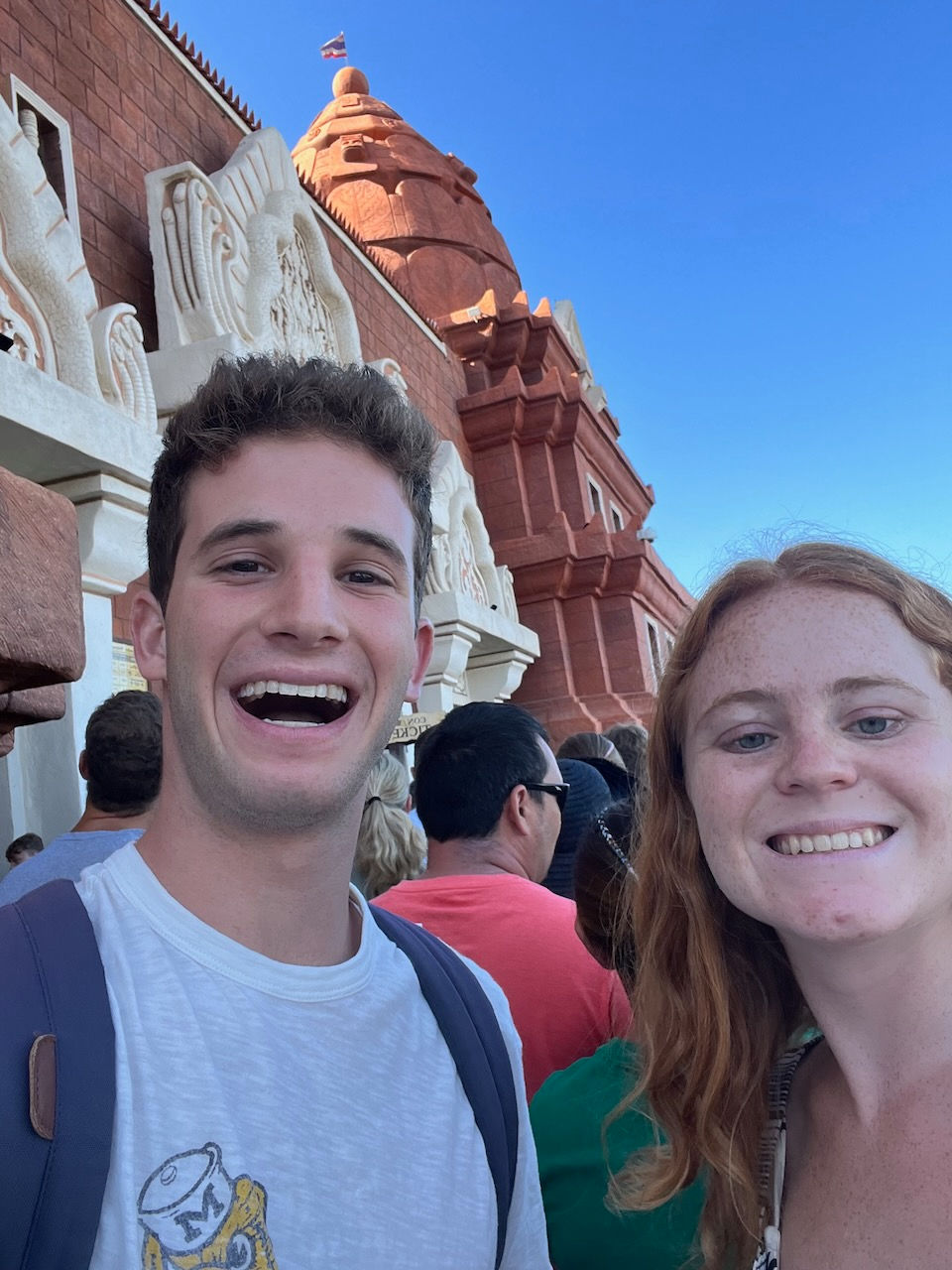The Island of Adventure!
- Ian Rosenberg

- Aug 7, 2023
- 11 min read
On Friday, Mercedes and I left for the final weekend trip, to Tenerife, in the Canary Islands. The Canaries are a volcanic archipelago off the coast of southern Morocco, famous for their wonderful weather, beautiful nature, nice beaches, and relaxed lifestyle. There are actually many native Canarians who live in Seville, and I have talked with several of them before coming here, hearing conflicting opinions on which islands were the best to visit, what nature is worth seeing, and whether we'd need a rental car or not, just to name a few. In the end, we ended up booking flights to Tenerife because it was the most conveniently timed flights, and it is one of the two most famous islands, the other being Gran Canaria. Had we had more time there, we would have probably taken a ferry to a different island, but we were trying to squeeze a lot into just a short two days, so we stayed on Tenerife the whole time.
Not necessarily related to the trip itself, but Mercedes and I finally took the Airport Bus, which we've been trying to take to avoid the 16€ Uber, but a one way ticket costs 4€, as we found out on board, so it's not actually saving us that much money when we travel together.
I'll skip some details, and get straight to the exciting part of the trip!
Saturday morning, we woke up and got in the car we'd scheduled to take us from our hostel in El Médano, an up-and-coming town in the southeast of the island, to the Parque Nacional del Teide. El Teide is the main, stratovolcano of Tenerife, at practically the center of the island. When we stepped outside, we were relieved to feel a nice breeze, a bit of shade from the clouds, and air that wasn't, frankly, a hundred degrees. But what was disappointing, in the moment, was that there were lots of clouds. I was nervous that the peak of Teide would be obscured by the clouds, but as you'll see soon, that was not a worry in the slightest.
Our driver, Andrea, was wonderful. First of all, he charged us significantly less than a taxi would have, probably because he was affiliated with our hostel, and also, he gave us an hour and a half long history, geology, geography, and politics lesson on our drive up there. He's from Italy, outside of Venice, and only moved to the Canaries a year and a half ago, following the lockdowns and a slump he experienced due to them. Despite that, he's extremely knowledgeable about seemingly everything on the island, and was excited to share his knowledge with us. We started by driving out of El Médano. Médano means sand dune in English, and it's an appropriate name, since there's a medium-sized mountain called Montaña Roja clearly visible from the coast anywhere in El Médano. It's also visible from the airport, so here's a picture of it from the tarmac. I suppose that this "mountain" could be considered a sand dune if you squint your eyes and tilt your head...
The area of El Médano, as well as much of the southeast of the island, was formed by a massive landslide. The characteristically white soil in these areas is identical to soil much higher up, closer to the peak, and the soil comes from the sides of an ancient volcano that collapsed, dumping enough soil into the water to form new shelves of land. As we continued to drive westward, we saw the soil start to change from that white color, to a more dark, ashy black color. These black soils are composed of ash from more recent explosive eruptions. Teide typically erupts about once every hundred years, with the last two being in 1909 and 1798. So we are, indeed, past-due for an eruption. However, most eruptions of Teide are not devastating, instead, creating a flow of lava from one of the vents on the side. Were the peak of Teide to erupt, it would certainly create pyroclastic flows, destroying whatever towns lay in its path. When we were close to Teide, and in the national park, we could also see Lavas Negras, the pitch black, igneous rocks formed by Teide's explosive eruption millennia ago. There are also blue rocks scattered in areas around the park, which were formed by the interaction of the lava with seawater, producing, what Andrea told us, at least, a large amount of fluorite in the rocks. On the ground, geologically, it looks very similar to Iceland, actually. There are lots of black rocks with moss growing on them, and the landscape is rugged. The rocks, being igneous, are very light, and make a satisfying, glassy "clink" when you knock them together.
Teide, being so tall, splits the island in half. We stayed the entire time on the south, which is the more touristy side, however I've been told by everyone I've talked with about Tenerife that there is a stark difference. The south is mostly small towns. There isn't a walkable city around there. El Médano, for example, is only about ten minutes from end to end, and you need to take a bus to get anywhere that's not downtown El Médano. But scattered around the south are towns like this. Andrea told us that it wasn't like this forty years ago, that the tourism industry has really boomed. Especially with the Brits (so much in fact that the departure board when we were flying out was entirely flights to the British Isles, with the exception of one to Gran Canaria and ours). The north of Tenerife houses the island's only real city, Santa Cruz de Tenerife. There are much fewer tourists there, and their airport, I've been told, serves mostly domestic flights. Most notably, there is a difference in the weather. Teide creates two climate zones, a more rainy north, and a more sunny south. So, I brought up the clouds earlier... they went away soon into our drive, but it wouldn't have mattered anyways, as we ascended well above the clouds, before even entering the Parque Nacional. But there was one view we got on the drive that really demonstrated this dual climate-zone point. Looking out to the western end of the island, we saw a thick blanket of clouds to our north, stopping abruptly at the park, and not continuing to the south. This is a hard, geographic border for what constitutes Tenerife Norte from Tenerife Sur. Andrea said that even the color of the plants is different, as the north gets more rain and less shine.
We talked about some other things in the car as well, such as how he's camping in the national park for a week or so, and his love for real, American football! He is the first European I've met who is more into football than soccer, and it was funny hearing him talk about it. Apparently, the NFL had some sort of marketing campaign in Italy when he was younger, and he fell in love then. It didn't pan out, obviously, but he still follows the NFL religiously. He's a Miami Dolphins fan, in case you were curious. We also talked about where he would go if he went to the US, and again, I've rarely heard a European talk so excitedly about the US. It makes me happy to know that not everywhere, not everyone has a negative view of the US, as it often frustrates me, hearing people who've never been to the US badmouth us.
When we arrived at the trailhead, we quickly grabbed a trail map, asked for a recommendation for trails to take, and got going. We were planning to be there for 4.5 hours, and the lady gave us an easy trail, basically a long walk through the park. But she suggested that if we were up for a good hike, we could do the Montaña Guajara hike (the top of Montaña Guajara is seen at the top of the right picture), which was previously the peak in the place where Teide now is. It's significantly less tall than Teide, but Andrea had told us on the ride over there that Guajara is the hardest hike in the park, but it gets some great views. We were up for the challenge, and began to summit it. It wasn't awful, but it wasn't easy for sure. In total, we ascended over 2,000 feet, with the ascent of Guajara making up about 1,850 of those. At the top, the view was unbelievable from every direction. Obviously, straight ahead, you got a face-to-face view with El Teide, with the massive caldera separating us. If you turn around, you can see three other islands: La Palma and La Gomera to the west, and Gran Canaria to the east. They too surpass the clouds, and you can just see their peaks above the cloud level, nothing underneath.

At the top, we saw two locals who were enjoying a lunch of goat cheese and Iberian ham. They generously invited us over to try a bit of cheese and talk for a little. Though they are both Tenerife natives, this was only their third time up Guajara, though they've been to the park countless times. We offered our M&Ms to them, but they didn't want any...
The way back was less steep, so it seems that we did the hardest hike in the park in the harder direction, though I think going down shallower is easier on the feet, especially since neither of us have hiking boots with us in Spain. We met Andrea back at the trailhead after 4:10 and 7.33 miles, where he was impressed that we did Guajara, and in that time span too. He said that when he leads tours on that hike, it usually takes them five to six hours. But, in fairness, we are just two people, so we call a break when half the group is tired, not, say, one tenth. And, we're not old farts.
The top of the Guajara hike and the trailhead can be both seen in the third picture, to get a sense of our trek. Notice too in the last picture just how far above the clouds we were.
We rode back to El Médano, talking about the native Canarian population, how they knew their land very, very well, and were able to ward off invasion for centuries. Nowadays, Andrea says that there's people who want independence from Spain, but the majority are happy with the amenities, lifestyle, and economy that being part of Spain brings. Once we got back, we quickly changed into our bathing suits and headed for the beach. The beaches are black sand here, as you may expect from a volcanic island not too dissimilar from Iceland. The first place we went was very rocky and treacherous, but the second beach, just minutes away, was much more relaxing. We stayed there until dinner.
For dinner, we ate in the main square of El Médano. El Médano is the definition of a beach town. It's colorful, it was actually breezy and chilly enough for us to put on a sweatshirt, and everyone's out and about. The ambiance was wonderful, despite the restaurant seating us next to a cement wall blocking the view of the square... The square was filled with presumably locals and tourists, all just at and around the beach, enjoying the wonderful Saturday night weather, getting a drink or dinner. In the center of the square was a stage, presenting a mix of popular musicians and Canarian cultural artifacts, such as some (not so pleasant) singing that seemed to be native to the region, and this cool staff fighting demonstration. Originally, it wouldn't have seemed out of place in Japan, for example, however the clothes they were wearing were iconically not Japanese. They must be ethnic clothes of the Canaries as well, since I've never seen clothes like that anywhere else. I got octopus, prepared in a different way from what I'm used to in Spain. Usually, they do it in the Gallega (Galician) style, which has paprika on it, it's served cold, and cut into medallions. This was served to me almost like a steak, and it was fresh off the grill, seasoned with something delicious that was certainly not paprika. Though I like Pulpo a la Gallega a lot, I think this octopus had Galician octopus well beat. We also ordered a Spanish classic that we'd just never ordered before. I had it last time I was in Spain, but not since. It's Pimiento de Padrón, a plate of green peppers, grilled, oiled, and salted. We were hungry enough that it really didn't matter whether we liked them or not (which I did, just not loved them...)
We continued to just walk around, grabbing a drink at a few different places, admiring the vibes along the beach, and getting an ice cream before going home.
The next morning, we went to the world's number one waterpark for the last nine years according to TripAdvisor, Siam Park. And before you ask, yes, it is a Thailand themed waterpark on a Spanish island off the coast of Africa. It was very fun, and we had a great day. Best waterpark in the world, I'd say no, I still think Volcano Bay was significantly better, and their line-management system, where you wait virtually for a ride instead of standing in line, is far superior to the traditional lines of Siam Park. But being in a place literally designed to look like if Thailand was one massive water park was very cool nonetheless. All the rides had pagodas, Buddha heads, and other classic architecture around them. The most famous ride was the Tower of Power, which drops you almost 100 ft at a very steep angle, and at the bottom, you pass through an aquarium filled with sharks and rays. It would have been cool to pass through it if I could see though! There was so much splash that I just knew I was in the aquarium because the lighting changed to blue...

Otherwise, the rides were really good. Definitely high quality rides. Our favorite ride, the Singha, is one of those slides that can push you up a hill with strong jets of water. We did it twice, as when our fast pass activated at 2 PM, we were able to skip to the front to ride it another time. They also had a lazy river which turns into a waterslide, though the system to get to this extra waterslide part is very poor. We missed it the first time, so we went back around the entire lazy river just to catch it. Then, there's a massive traffic jam as the entire lazy river tries to merge into a single lane, whose only way out is the elevator taking one tube every five to ten seconds to the top. It's nearly cutthroat, because if you don't stay as close to this narrow channel as you can, you may get pushed aside and sent to go around another time. This waterslide was very worth the extra lap around, and it finishes in the same shark-ray tank that the Tower of Power drops into, but this time, we really got to admire the animals...
(These are stock images from the Siam Park website...)
Last thing to mention about the park was that the menu said there would be Asian food at lunch, but all we could find were chicken tenders. I was quite disappointed, as I wanted some good spicy chicken stir fry to eat at a waterpark, since, well, at what other water park would there be that?!
We left the park and got onto our first Guagua, which is the Tenerife nickname for bus. We figured out the system pretty well, and ended up taking the Guaguas to the airport as well. We enjoyed some hamburgers at a beachy restaurant right across from our hostel, before heading to the airport and home. The Guaguas run notoriously infrequently, and tourists usually find them difficult to use, so we were proud to have used them as much as we did. We did miss our connecting us to the airport, but there was one coming in not too long that also stopped there, so no big deal in the end.
It was a really exciting weekend, packed with activities, and exploring as much as we could in the short time we had! I am very glad we went, as these weekend trips were starting to get really exhausting, but I suppose I've got the coming two weeks to recover before I move in for school.


























Comments